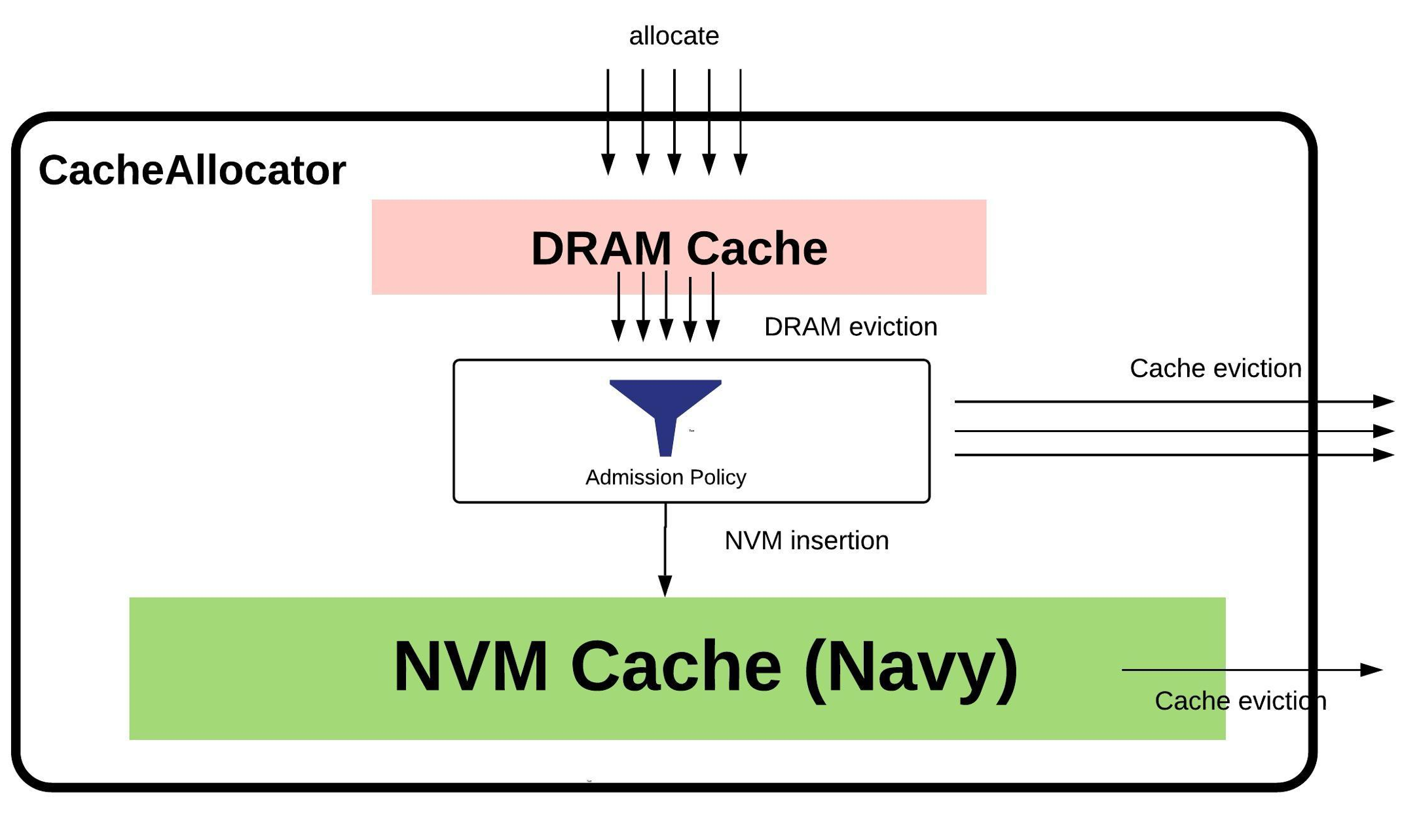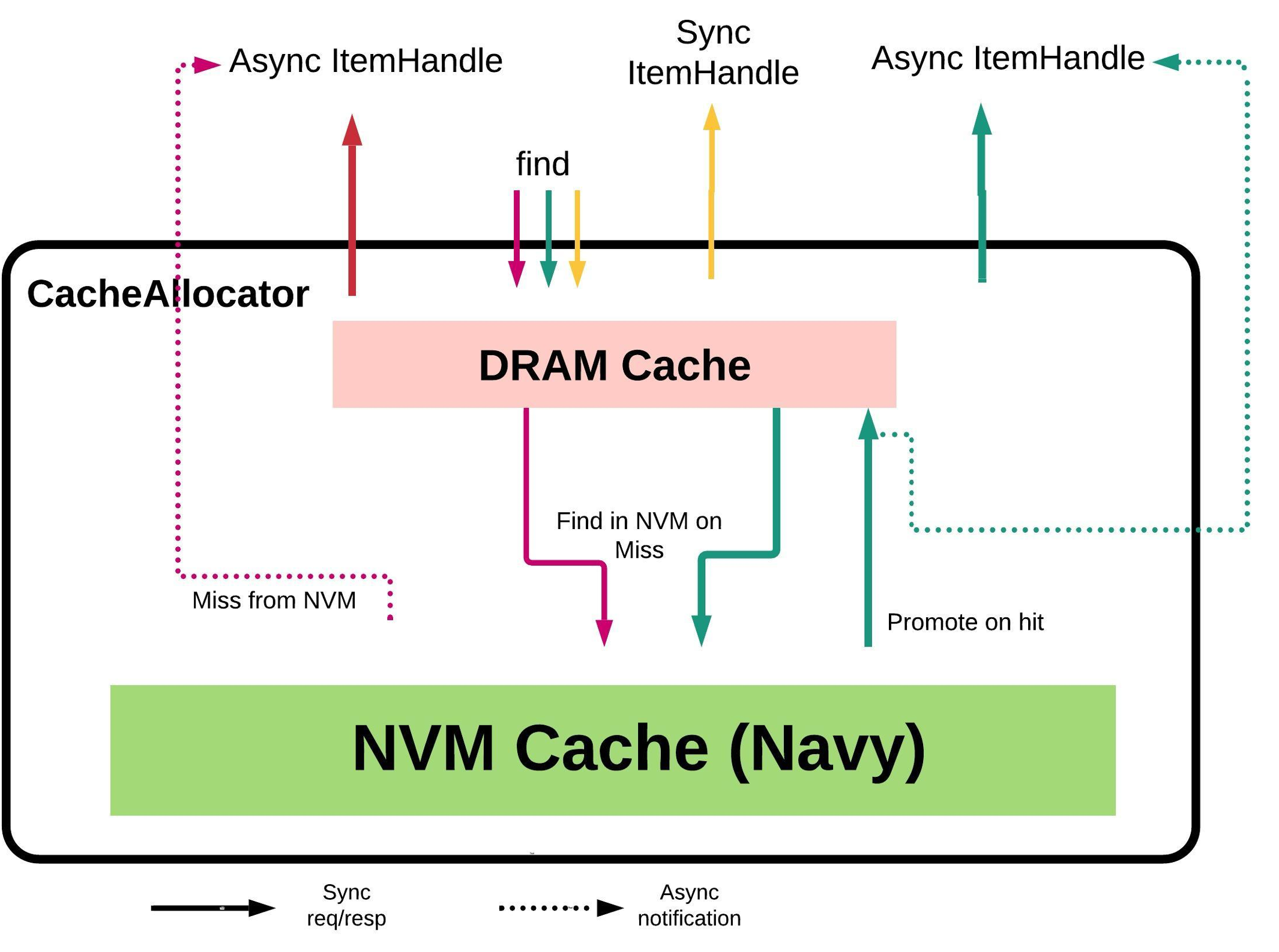Hybrid Cache
CacheLib supports use of multiple HW mediums through hybrid cache feature. To make this transparent to the user, the CacheAllocator API is extended to support caching items in both DRAM and NVM. Barring few features, users should not be aware of whether the Item is cached in DRAM or NVM.
Overview of Hybrid Cache design
Currently we support SSDs as the NVM medium for Hybrid Cache. Navy is our SSD optimized cache engine. To interface with Navy, CacheAllocator uses the NvmCache wrapper. CacheAllocator delegates the responsibility of performing thread safe lookups, inserts and deletes for Navy to NvmCache. NvmCache implements the functionality that handles transitions of Item to and from NVM. Since there is no global key level lock in CacheAllocator to synchronize operations that change Item's state between DRAM and NVM, NvmCache employs optimistic concurrency control primitives to enforce data correctness.
Item allocation and eviction
CacheAllocator allocates the Item in DRAM when allocate is called. Once the Item becomes a victim for eviction in the MMContainer, CacheAllocator evicts the Item to NvmCache. Since NVM has constraints on write endurance, CacheAllocator supports a pluggable admission policy that can reject Items when needed or suitable. Items read from NVM are also inserted into DRAM. When these Items get evicted, CacheAllocator can choose to not write them into NVM since it is already present by inferring if it->isNvmClean().

Item lookups
When performing lookups through find, CacheAllocator first checks if the Item is present in DRAM. If not, it looks into NvmCache and if present, fetches the Item asynchronously, and inserts them into DRAM. Since Items can be asynchronously moved from NVM to DRAM, we extend the functionality of Item's Handle (see Accessing items on cache) to expose the async nature of the Item in hybird cache. Item's Handle internally holds a WaitContext that is shared between all outstanding Handles for the same key. The WaitContext holds a baton that is used to communicate when the Item is ready and available in DRAM. The overhead of WaitContext is only incurred when hybrid cache is enabled. In pure DRAM setups, the Item's Handle simply encapsulates an active reference of an Item.

When NvmCache inserts Items into DRAM from NVM, they are marked to indicate NvmClean so that future evictions can skip re-writing them unless the Item has been mutated.
Optimistic concurrency in NVMCache
CacheAllocator does not employ any key level locks to protect the state of an Item between DRAM and NVM. This is motivated from having to avoid holding any locks that can potentially contend over IO operations into NVM. Instead, it relies on the intuition that concurrent mutations to Item's state within the cache is very rare and leverages optimistic concurrency. For example, while Thread1 looks up for an Item in NVM, Thread2 could be allocating and inserting an Item. There are more subtle races co-ordinating the lookup of an Item with eviction of the Item into NVM in the absence of global per key mutex. For all inflight operations, NvmCache maintains book keeping. PutTokens represent the in-flight evictions that will be inserted into NVM. DeleteTombstone represent an in-flight indication of preparing to purge a key from DRAM and NVM. A GetContext is used to track in-flight lookups into NVM.
On lookups, NvmCache ensures that any in-flight eviction from DRAM into NVM is aborted to preserve the consistency of lookup order between NVM and DRAM. When lookup for NVM completes, before inserting the Item into DRAM, any outstanding DeleteTombstone is respected by ignoring the value read and returning a miss instead. This ensures that once a delete is enqued by the user through remove API, any lookups started after return a miss, even if the lookup is executed concurrently ahead of the remove by another thread. The effect of this is that we serialize any rare occurence of concurrent in-flight lookups, deletes and insert to the same key without blocking the threads over IO operations.